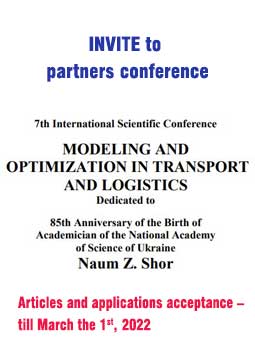UDC 338.4:658.8
DOI: https://doi.org/10.46783/smart-scm/2022-15-3
JEL Classification: M11, O18, Q20, R13.
JEL Classification: M11, O18, Q20, R13.
Received: 15 September 2022
-
Karpun O.V. PhD of Economics, Associate Professor, Associate Professor of Logistics Department of National Aviation University
Ukraine - ORCID: 0000-0003-2058-9070
- Web of Science ResearcherID: -
- Scopus author id: -
-
Marchuk V.Ye. Doctor of Engineering, Professor, Professor of Logistics Department National Aviation University
Ukraine - ORCID: 0000-0003-0140-5416
- Web of Science ResearcherID: S-6514-2018
- Scopus author id: 57212323045
Anotation: The article defines the essence of the logistics customer service concept, as a component of the service process, which makes it possible to ensure the necessary level of the customers’ needs satisfaction, while providing the minimum necessary level of costs and maximizing profit for the company.
It was determined that the basis of the formation of logistics customer service is their segmentation or differentiation. A classic logistic approach to the differentiation of customers can be considered their division using ABC-XYZ analysis. At the same time, ABC analysis is usually carried out based on the income brought by clients for a certain period of time, XYZ analysis is carried out according to the stability of relations with the client, that is, according to the number of orders placed by the client during the same period of time.
We proposed our own view on the direct process of dividing customers into groups A, B and C, which is based on the calculation of the “jump in share” of customer revenues. The advantage of the proposed approach is that customers with relatively equal importance to the company cannot fall into different categories, and customers with very different values of importance to the company cannot fall into the same category.
Another approach to customer differentiation based on customer profitability was also proposed and recommendations for servicing each customer group were made.
Thus, the correct segmentation of customers and assessment of the potential of each segment will allow building several different service strategies aimed at increasing the company’s profits.
Keywords: logistics service, customer segmentation, logistics approach to customer segmentation
Анотація: У статті визначено сутність поняття логістичного обслуговування клієнтів, як складової частини процесу обслуговування, яка дає можливість забезпечити необхідний рівень задоволення потреб різних категорій клієнтів за умови підтримки мінімально необхідного рівня витрат та максимізації прибутку для самої компанії.
Було визначено що основою формування логістичного обслуговування клієнтів є їх сегментації або диференціації. Класичним логістичним підходом до диференціації клієнтів можна вважати їх поділ за допомогою АВС-XYZ аналізу. При цьому АВС аналіз зазвичай проводять за доходами, які приносять клієнти за певний період часу, XYZ аналіз проводять за сталістю відносин з клієнтом, тобто за кількістю замовлень, розміщених клієнтом, за той же період часу.
Був запропонований власний погляд на безпосередній процес поділу клієнтів на групи А, В та С, в основі якого лежить розрахунок «стрибка питомої ваги» доходів клієнтів. Перевагою запропонованого підходу є те, що клієнти зі порівняно однаковими важливістю для компанії не можуть потрапити до різних категорій, а клієнти з дуже різними значеннями важливості для компанії не можуть потрапити до однієї категорії.
Також був запропонованих ще один підхід до диференціації клієнтів, заснований на прибутковості клієнтів, та надані рекомендації щодо обслуговування кожної отриманої групи клієнтів.
Таким чином, правильна сегментація клієнтів і оцінка потенціалу кожного сегмента дозволять побудувати кілька різних стратегій обслуговування, спрямованих на збільшення прибутку компанії.
Ключові слова: логістичне обслуговування, сегментація клієнтів, логістичний підхід до сегментації клієнтів.
List of references
- Christopher M., Peck H. Marketing Logistics. 2012, 168 р.
- Customer Service in Logistics: Roles & Importance. URL: https://www.revechat.com/blog/customer-service-in-logistics/.
- Curry A., Curry J. The Customer Marketing Method: How to Implement and Profit from Customer Relationship Management. 2002, 256 р.
- Karpun O.V. Lohistychne obsluhovuvannia v systemi obsluhovuvannia spozhyvachiv // Problemy pidvyshchennia efektyvnosti infrastruktury: zb. nauk. prats. – K.: NAU, 2008. – Vyp. 20. – S.188-193.
- Karpun O.V. Lohistychni pryntsypy sehmentuvannia spozhyvachiv kompanii // Problemy systemnoho pidkhodu v ekonomitsi: zb. nauk. prats. – K.: NAU, 2009. – Vyp. 30. – S. 135-140.
- Karpun O.V. Pidvyshchennia efektyvnosti vidnosyn z kliientamy kompanii na zasadakh lohistyky// International Scientific-Practical Conference from Baltic to Black Sea: National Models of Economic Systems: Conference Proceedings, March 25, 2016. Riga: Baltija Publishing. – P.108-111.
- Kotler F. A framework for marketing management. URL: https://dut.edu.ua/uploads/l_1237_68922187.pdf.
- Sarder M.D. Logistics customer services. URL: https://www.ncbi.nlm.nih.gov /pmc/articles/PMC7563975/#:~:text=Logistics%20customer%20service %20is%20a,of%20filling%20the%20customer's%20order.
HOW TO QUOTE THIS ARTICLE:
Karpun O.V., Marchuk V.Ye. (2022) “Logistic approach to the segmentation of the company’s customers as a basis for the formation of logistics services”. – Intellectualization of logistics and Supply Chain Management. [Online], vol.15, pp.36-45, available at: https://smart-scm.org/en/journal-15-2022/logistic-approach-to-the-segmentation-of-the-company-s-customers-as-a-basis-for-the-formation-of-logistics-services/. DOI: https://doi.org/10.46783/smart-scm/2022-15-3


